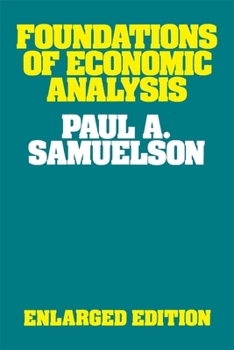Foundations of Economic Analysis, Enlarged Edition
Select Format
Select Condition 
Book Overview
Although his classic work has gone through many reprintings and translations, only now has Paul A. Samuelson added new material to his 1947 treatise. A new introduction portrays the genesis of the book and analyzes how its contributions fit into theoretical developments of the last thirty-five years. A new and lengthy mathematical appendix gives a survey of the following post-1947 breakthroughs in political economy, in relation to the methodology of Foundations : linear programming and comparative statics; nonlinear programming, dynamic and stochastic; modern duality theory; the testable content of the neoclassical money model; probabilistic decision making, with new slants on the dogma of Expected-Utility maximizing; and portfolio and liquidity preference analysis by general methods that transcend mean-variance approximations.
Format:Paperback
Language:English
ISBN:0674313038
ISBN13:9780674313033
Release Date:January 1983
Publisher:Harvard University Press
Length:604 Pages
Weight:1.72 lbs.
Dimensions:8.4" x 1.4" x 5.8"
Customer Reviews
1 rating
Absolutley Seminal
Published by Thriftbooks.com User , 25 years ago
Samuelson's "Foundations" may be the most important book on mathematical economics ever written. This remarkable book thoroughly treats every area of modern economic theory -- from international trade to portfolio theory -- in an elegant and concise manner. Every equation derived is done so methodically, without the logical leaps that typify most technical textbooks and monographs. Altough the mathematics of the book are what gives "Foundations" its great authority (see Samuelson on "The Apotheosis of the Calculus"), Samuelson's prose is lucid and engaging. This book is absolutely essential for any student of technical economics. But it did leave me wondering: does economics really lend itself, as physics does, and as Samuelson posits, to the most technical applied and theoretical mathematics? But no matter....







